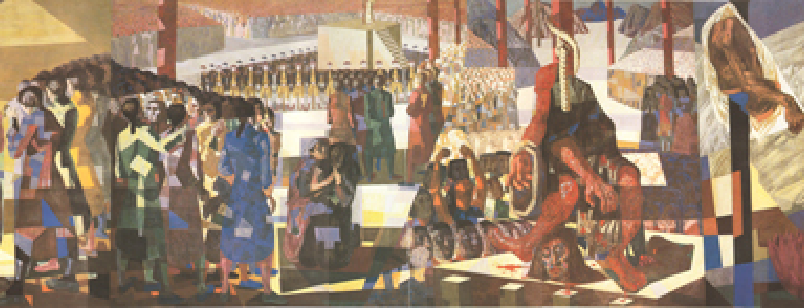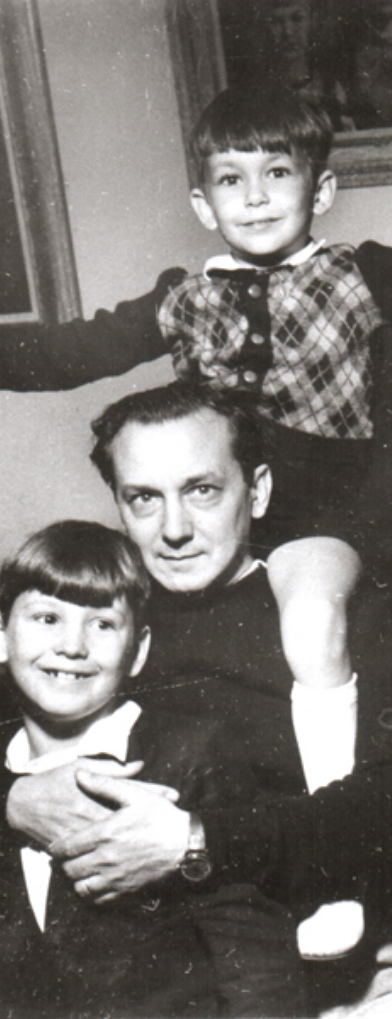
Candido Portinari was born on December 30, 1903, in a coffee farm in Brodowski, State of São Paulo. The son of Italian immigrants of a humble origin, he only studied elementary school. He showed an artistic vocation since childhood. At 15 years of age he went to Rio de Janeiro seeking a more systematic approach to studying painting, enrolling in the National Fine Arts School.
In 1928, he won the Travel Abroad award of the Genarl Fine Arts Exhibit, with academic tradition. He went to Paris (France) where he stayed throughout 1930. Away from his country and missing his people, Portinari returned to Brazil in 1931 and portrayed the Brazilian people in his canvases, gradually exceeding his academic background and fusing the ancient painting science with an experimentalist personality with a modern academia.
In 1935, he received his first acknowledgement abroad, the second honorable mention at the international Carnegie Institute exhibit in Pittsburgh, United States, with a large canvas entitled “Café” (Coffee), portraying a scene of the typical coffee harvest in his region of origin.
Portinari’s muralist inclination proved to be vigorous in the panels performed at the Highway Monument on the Rio de Janeiro – São Paulo road in 1936 and in the frescos of the new building of the Ministry of Education and Health done between 1936 and 1944. These works, as an artistic set and conception, represent a landmark in the evolution of Portinari’s art, stating the option for the social theme which was the driver of his entire work as of then.

The companion of poets, writers, journalists, diplomats, Portinari participated in the Brazilian intellectual elite at a time when there was a noticeable shift of the aesthetic attitude and the culture of the country.
In the late 1930’s, Portinari consolidated his projection in the United States. In 1939, he created three large panels for the Brazil pavilion at the New York World Fair. That same year, the New York Modern Art Museum acquired his canvas “O Morro” (The Hill).
In 1940, the artist participated in the Latin-American art exhibition at the Riverside Museum in New York and individually exhibited at the Detroit Art Institute and the New York Museum of Modern Art, with a great critic, sale and public success. In December that same year, the University of Chicago published the first book about the painter, “Portinari, His Life and Art”, introducing the artist Rockwell Kent and numerous reproductions of his art.
In 1941, Portinari created four large murals at the Hispanic Foundation of the Congress Library in Washington with themes referring to Latin-American history. Back in Brazil, in 1943 he created eight panels known as the “Série Bíblica” (Biblical Series), strongly influenced by the Picassian vision of “Guernica” and under the impact of the II World War.
In 1944, invited by architect Oscar Niemeyer, he began the work to decorate the Pampulha architectural complex in Belo Horizonte (MG), highlighting the mural “São Francisco” (Saint Francis) and “Via Sacra” (Stations of the Cross), at Pampulha Church. The increase of Nazi-fascism and the horrors of the war reinforced the social and tragic character of his work, leading him to produce the series “Retirantes” (Migrants) and “Meninos de Brodowski” (Boys from Brodowski), between 1944 and 1946, and his political militancy joining the Brazilian communist party and being a candidate for house representative in 1945 and senator in 1947. Still in 1946, Portinari returned to Paris for his first exhibition in European soil at Galerie Charpentier. The exhibition had great repercussion, with Portinari being honored by the French government with the Légion d’Honneur.
In 1947, he exhibited at the Peuser, in Buenos Aires (Argentina), and at the Fine Arts National Commission in Montevideo (Uruguay), receiving great tributes by the artists, intellectuals and authorities of those countries.
The end of the 1940’s marked the beginning of his exploration of historic themes through mural statements. In 1948, Portinari exiled himself in Uruguay for political reasons, where he painted the panel “A Primeira Missa no Brasil” (The First Mass in Brazil), ordered by Boavista do Brasil bank.
In 1949, he created the large panel “Tiradentes”, narrating episodes of the judgment and execution of the Brazilian hero who fought against the Portuguese colonial domain. For this work, in 1950 Portinari received the gold medal granted by the Jury of the International Peace Award, gathered in Warsaw (Poland).
In 1952, delivering the order from Banco da Bahia, he created another panel with a historical theme, “A Chegada da Família Real Portuguesa à Bahia” (The Arrival of the Portuguese Royal Family in Bahia) and began his studies for the panel “Guerra e Paz” (War and Peace), offered by the Brazilian government for the new United Nations Organization headquarters. Concluded in 1956, the panels measured approximately 14m x10m each – the largest painted by Portinari.
In 1955, he received the gold medal awarded by the International Fine Arts Council in New York as the best painter of the year. In 1956, Portinari traveled to Israel, invited by that country’s president, exposing at several museums and making drawings inspired by the recently created state of Israel and later exhibited in Bologna (Italy), Lima (Peru), Buenos Aires (Argentina) and Rio de Janeiro. That same year, Portinari received the Guggenheim do Brasil Award, and in 1957, the Honorable Mention at the Hallmark Art Award International Water Color Contest in Nova York. In the end of the 1950’s, he held several international exhibits.
Portinari exhibited in Paris and Munich (Germany) in 1957. He was the only Brazilian artist to participate in the 50 Years of Modern Art exhibits at the Palais des Beaux Arts, in Brussels (Belgium) in 1958. As the guest of honor, he exhibited 39 works in a special room at the I Mexico City Visual Arts Biennial in 1958. That same year, he exhibited in Buenos Aires, and in 1959 at the Wildenstein Gallery in New York together with other great American artists such as Tamayo, Cuevas, Matta, Orozco, and Rivera. He participated in the Inter-American Art Collection exhibit at the Museo de Bellas Artes de Caracas (Venezuela). Candido Portinari passed away on February 6, 1962, when he was preparing a big exhibit with about 200 works invited by Milan City Hall (Italy), victim of intoxication from the paints he used.

To request more information, clarify doubts or make suggestions, criticisms and comments related to any aspect of the Casa de Portinari Museum, contact us.
Press Officer
Fabiano Cruz
(16) 98257-0231
imprensa@acamportinari.org
Press officer
(11) 3339-8116 / (11) 3339-8162
(11) 98849-5303 (plantão)
imprensaculturasp@sp.gov.br
Download institutional information about the museum, photos of the institution's environments and works, as well as reference materials about the municipality, location and geographic distribution of Candido Portinari's artistic production.

Contact us to request more information, answer questions or make suggestions, criticisms and comments related to any aspect of the Casa de Portinari Museum through the contact form below. Please use this form.